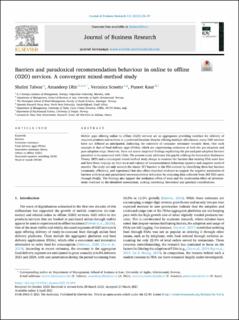| dc.contributor.author | Talwar, Shalini | |
| dc.contributor.author | Dhir, Amandeep | |
| dc.contributor.author | Scuotto, Veronica | |
| dc.contributor.author | Kaur, Puneet | |
| dc.date.accessioned | 2021-08-20T11:47:51Z | |
| dc.date.available | 2021-08-20T11:47:51Z | |
| dc.date.created | 2021-07-16T17:38:21Z | |
| dc.date.issued | 2021 | |
| dc.identifier.issn | 0148-2963 | |
| dc.identifier.uri | https://hdl.handle.net/11250/2770579 | |
| dc.description.abstract | Mobile apps offering online to offline (O2O) services act as aggregators providing interface for delivery of required products and services at a preferred location. Despite offering multiple affordances, many O2O services have not diffused as anticipated, indicating the existence of consumer resistance towards them. One such example is that of food delivery apps (FDAs), which are experiencing resistance at both the pre-adoption and post-adoption stage. However, there are scarce empirical findings explicating the pre-and post-adoption barriers perceived to be associated with FDAs. The present study addresses this gap by utilising the Innovation Resistance Theory (IRT) and a convergent mixed-method study design to examine the barriers that existing FDA users face and how these impinge on their trust and valence of recommendation behaviour (positive and negative word of mouth). The study not only extends the classic IRT barriers to the FDA-context by identifying three key barriers (economic, efficiency, and experience) but also offers empirical evidence to support the negative association of barriers with trust and paradoxical recommendation behaviour by analysing data collected from 303 FDA users through Prolific. The findings also support the mediation effect of trust and the moderation effect of advertisement overload on the identified associations, making interesting theoretical and practical contributions. | en_US |
| dc.language.iso | eng | en_US |
| dc.publisher | Elsevier | en_US |
| dc.rights | Navngivelse 4.0 Internasjonal | * |
| dc.rights.uri | http://creativecommons.org/licenses/by/4.0/deed.no | * |
| dc.title | Barriers and paradoxical recommendation behaviour in online to offline (O2O) services. A convergent mixed-method study | en_US |
| dc.type | Journal article | en_US |
| dc.type | Peer reviewed | en_US |
| dc.description.version | publishedVersion | en_US |
| dc.rights.holder | Copyright 2021 The Authors | en_US |
| cristin.ispublished | true | |
| cristin.fulltext | original | |
| cristin.qualitycode | 2 | |
| dc.identifier.doi | 10.1016/j.jbusres.2021.03.049 | |
| dc.identifier.cristin | 1921971 | |
| dc.source.journal | Journal of Business Research | en_US |
| dc.source.pagenumber | 25-39 | en_US |
| dc.identifier.citation | Journal of Business Research. 2021, 131, 25-39. | en_US |
| dc.source.volume | 131 | en_US |

